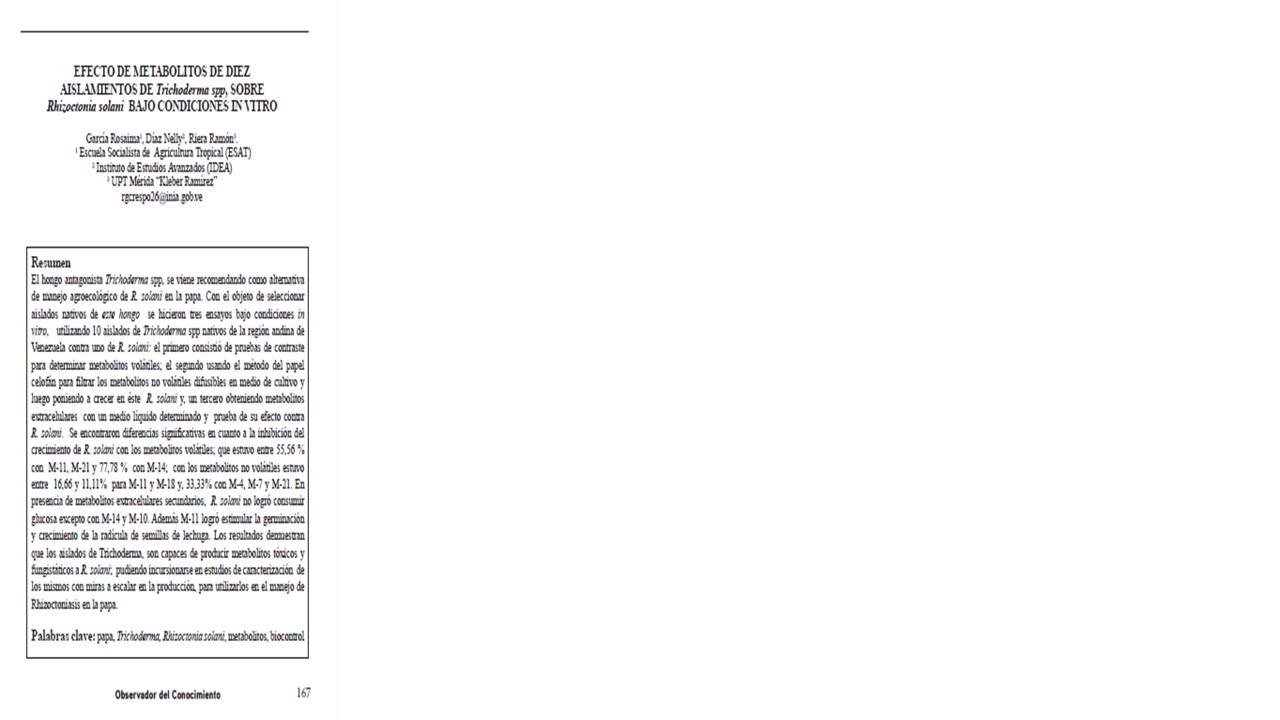Efecto de Metabolitos de Diez Aislamientos de Trichoderma SPP, sobre Rhizoctonia Solani bajo Condiciones In Vitro
Palabras clave:
Papa, Trichodermai, Rhizoctonia solani, metabolitos, biocontrolResumen
El hongo antagonista Trichoderma spp, se viene recomendando como alternativa de manejo agroecológico de R. solani en la papa. Con el objeto de seleccionar aislados nativos de este hongo se hicieron tres ensayos bajo condiciones in vitro, utilizando 10 aislados de Trichoderma spp nativos de la región andina de Venezuela contra uno de R. solani: el primero consistió de pruebas de contraste para determinar metabolitos volátiles; el segundo usando el método del papel celofán para filtrar los metabolitos no volátiles difusibles en medio de cultivo y luego poniendo a crecer en éste R. solani y, un tercero obteniendo metabolitos extracelulares con un medio líquido determinado y prueba de su efecto contra R. solani.
Descargas
Citas
Cardoza, R.; Hermosa, M.; Vizcaíno, J.; Sans, L.; Monte, E.; Gutiérrez, S. (2005). Secondary metabolites produced by Trichoderma and their importance in the biocontrol process. En Microorganism for industrial enzymes and biocontrol. Mellado E. y Barredo J. L(eds). Reseachs Signpost, Kerala, India. pp. 1-22.
Dennis, C.; Webster, J. (1971). Antagonist properties of species-groups of Thichoderma. I. Production of non volatile antibiotics. Trans. Brit Mycol. Soc. 57:25-39.
Dennis, C.; Webster, J. (1971). Antagonist properties of species-groups of Thichoderma. II. Production of volatile antibiotics. Trans. Brit Mycol. Soc. 57:47-4.
Fraga, B.; Hernández, M.; González, M.; Garbarino, J. (2000). The biotransformation of 18-Hidroxy-9- epi-ent-pimara-7,15diene by Gibberella fujikuroi. Phytochem 53:395-399.
García, R.; García, A.; Garnica, J. (2002). Distribución, Incidencia y Alternativas de Control de Rhizoctonia solani en el cultivo de la papa en el estado Mérida, Venezuela. Revista Latinoamericana de la papa. 13(1): 24-40.
García, R.; Salas, J.; Ramos, G. (2005). Producción de semilla de papa en Venezuela. Serie manuales de cultivo, INIA Nº5.
Harman, G.E. (2004). Mythos and dogmas of biocontrol. Changes in perceptions derive from research on Trichoderma harzianum T22. Plant Dis.84:377-393.
Harman, G.E. (2006). Overview of mechanisms and uses of Trichoderma spp. Phytopathology. 96: 190
-194.
Howell, C.R. (2003). Mechanisms employed by Trichoderma species in the biological control of plant diseases: The history and evolution of current concepts. Plant Disease. 87(1): 4-10.
Reino, J. L.; Guerrero, R. F.; Hernández- Galán, R.; Collado, I. (2008). Secundary metabolites from species of the biocontrol agent Trichoderma. Phytochem Rev. 7: 89-123.
Sivan, A.; Elad Y.; Chet, I. (1984). Biological Control Effects of New isolate of Trichoderma
harzianum on Pythium aphanidermatum. Phytopathology .74: 498-501.
Tudzynski, B. (1999). Biosynthesis of gibberellins in Gibberella fujikuroi: biomolecular aspects. Appl. Microbiol Biotechnol. 52: 298-310.
Vinale, F.; Marra, R.; Scala, F.; Ghisalberti, E. ; Lorito, M.; Sivasithamparam, K. (2006). Major secondary metabolites produced by two commercial Trichoderma strains active against different phytopathogens. Lett Appl. Microbiol. 43: 143-148.
Weindling, R. (1934). Studies on lethal principles effective in the parasitic action of Trichoderma lignorum on Rhizoctonia solani and other soil fungi. Phytopathology 24: 1153-1179.
Weindling, R.; Emerson, O. (1936). The isolation of a toxic substance from the culture filtrate of a Trichoderma. Phytopathology. 26: 1068-1070.

Descargas
Publicado
Cómo citar
Número
Sección
Licencia

Esta obra está bajo una licencia internacional Creative Commons Atribución-SinDerivadas 4.0.







